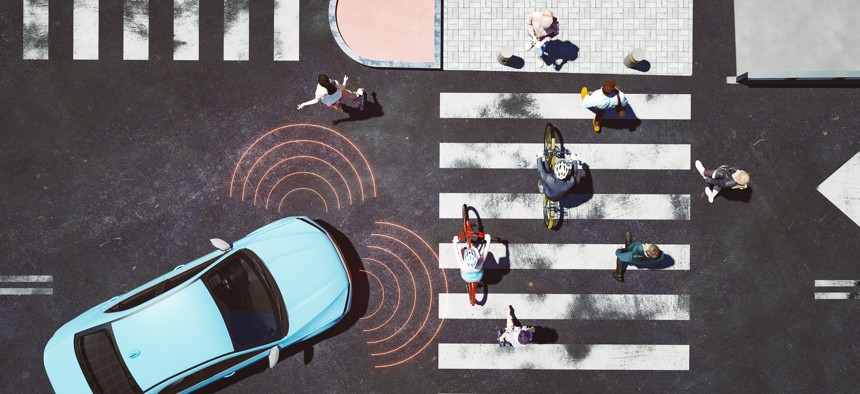Connecting state and local government leaders
COMMENTARY | Autonomous vehicles should be thoughtfully integrated into a balanced transportation system that also accommodates pedestrians, transit riders and cyclists.
In recent years, technology companies and vehicle manufacturers have poured billions of dollars into the development of autonomous or self-driving vehicles, with mixed results. In a few cities, residents can use their smartphone to hail an AV for a ride within a limited geographic area. Exactly when these vehicles will become truly autonomous, capable of operating on any roadway no matter what the weather conditions, is an open debate.
Nonetheless, these early attempts at AVs reveal the pressing need to think about what kind of transportation system we want in the future. The choices we make in the coming years are not trivial and will shape our communities for decades to come.
Unfortunately, recent research on connected and autonomous vehicles indicates that we are headed down a path that deepens our dependence on cars at the expense of sustainable, affordable and equitable alternatives such as public transportation, biking and walking.
For instance, a study by researchers at North Carolina State University demonstrates how a singular focus on leveraging AVs to improve vehicle throughput will make it all the more challenging to create an inclusive and sustainable transportation system. The title of the study is a mouthful: "Effects of Connectivity and Automation on Saturation Headway and Capacity at Signalized Intersections." The researchers at NC State investigated what would happen at a signalized intersection on a major arterial roadway as more connected and autonomous vehicles appear.
The results are based on multiple simulations that model roadway traffic. The researchers’ principal finding is that more connected and autonomous vehicles on the roadway would improve overall intersection performance, meaning more vehicles would pass through an intersection during each light cycle. According to the paper, a significant advantage of connected autonomous vehicles is that they will be able to "adjust their speeds to avoid stopping at the intersection..." There is no reason to believe that these results are anything but accurate.
The researchers, however, did not consider pedestrians or cyclists or any other group of vulnerable users, including children, the elderly or people with physical disabilities. Crucially, the case study intersection used to model the results included no crosswalks, sidewalks or bike lanes, which are the very design features that are essential to reducing automobile dependence. In other words, the paper modeled a future transportation system built to serve vehicles but no one else.
Another study by researchers as the Massachusetts Institute of Technology entitled “Learning Eco-Driving Strategies at Signalized Intersections” looked at ways to train connected and autonomous vehicles to reduce fuel consumption and greenhouse gases “while minimizing the impact on travel time.” This is another way of saying the researchers sought to maximize vehicle speed. Similar to the NC State paper, the study made no mention of pedestrians, cyclists, or other vulnerable roadway users.
Imagine stepping out to cross a street while approaching vehicles are algorithmically making adjustments to avoid coming to a full stop to either save fuel or increase the number of vehicles that make it through each light cycle. It’s enough to make you think twice about walking.
And that’s the problem. The infrastructure we build today and how we program AVs will shape our lives and communities for generations to come.
The best way to reduce congestion is not to use computers to squeeze a few more vehicles through an intersection during each light cycle. The most efficient solution is to not drive in the first place because there are ample, safe and affordable alternatives.
This is not the first time that a new transportation technology has disrupted how we use our road network. At the start of the 20th century, roadways were shared by pedestrians, cyclists, horses, carriages, streetcars, a few automobiles and even the occasional vendor. Until Ford released the Model T in 1907, cars had been expensive, bespoke luxuries available to only a small number of people. According to the U.S. Department of Transportation, in 1900, there were only 8,000 registered vehicles in the entire country. By 1930, this number had shot up to more than 23 million.
The presence of so many cars on city streets led to political conflict over the best way to use public rights of way. Drivers wanted roads to be for cars and cars alone, and in the end the drivers won. This meant ripping up streetcars, removing vendors and relegating everyone outside of a vehicle to the roadside since sidewalks were often not available. Before long, cities were spending heavily to widen narrow streets into major avenues. States began building highways. And in 1956, Congress passed the Eisenhower Interstate Highway Act, unleashing decades of federal investment on highway development.
The result has been a transportation system dominated by driving. Whether picking up a gallon of milk a few blocks from home or traveling across state lines, driving remains the only practical choice for millions of households. For too many families, buying and maintaining a vehicle (or vehicles) has become an expensive and burdensome requirement to access jobs, education and health care, among other essential needs. Transportation is often the second largest household expense behind rent or a mortgage.
For decades, the focus of state transportation departments has been to try and move more cars faster through a combination of pouring pavement and eliminating anything that might slow vehicles down. If we take a hands-off approach to the emerging technology of AVs, this pattern will repeat itself.
Fortunately, the die is not cast. We can learn from past mistakes by ensuring that advanced vehicles are thoughtfully integrated into a balanced transportation system. Accommodating pedestrians, transit riders and cyclists cannot be an afterthought. Communities and transportation systems must be built around people, not motor vehicles. A transportation system that only makes room for sophisticated AVs is a system and a future not worth having.

NEXT STORY: Passenger rail gets ‘unprecedented’ $16B investment



